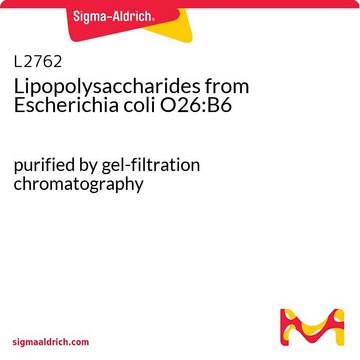L3880
Lipopolysaccharides from Escherichia coli O127:B8
purified by trichloroacetic acid extraction
Synonim(y):
LPS
Zaloguj sięWyświetlanie cen organizacyjnych i kontraktowych
About This Item
Polecane produkty
pochodzenie biologiczne
Escherichia coli (O127:B8)
Poziom jakości
Formularz
lyophilized powder
oczyszczone przez
trichloroacetic acid extraction
zanieczyszczenia
1-10% Protein (Lowry)
Warunki transportu
ambient
temp. przechowywania
2-8°C
Szukasz podobnych produktów? Odwiedź Przewodnik dotyczący porównywania produktów
Opis ogólny
This product is TCA extracted from E. coli serotype O127:B8. The source strain is ATCC 12740. This LPS serotype has been used in the study of septic shock and to induce NOS in murine macrophages and PAF synthesis in rat glomerular masangial cells.
Zastosowanie
Lipopolysaccharides (LPSs) are characteristic components of the cell wall of Gram-negative bacteria. LPS and its lipid A moiety stimulate cells of the innate immune system by the Toll-like receptor 4 (TLR4), a member of the Toll-like receptor protein family, which recognizes common pathogen-associated molecular-patterns (PAMPs).
Działania biochem./fizjol.
Lipopolysaccharides (LPS) are localized in the outer layer of the membrane and are, in noncapsulated strains, exposed on the cell surface. They contribute to the integrity of the outer membrane, and protect the cell against the action of bile salts and lipophilic antibiotics.
Uwaga dotycząca przygotowania
The product is soluble in water (5 mg/ml) or cell culture medium (1 mg/ml) yielding a hazy, faint yellow solution. A more concentrated, though still hazy, solution (20 mg/ml) has been achieved in aqueous saline after vortexing and warming to 70-80 oC. Lipopolysaccharides are molecules that form micelles in every solvent. Hazy solutions are observed in water and phosphate buffered saline. Organic solvents do not give clearer solutions. Methanol yields a turbid suspension with floaters, while water yields a homogeneously hazy solution.
Inne uwagi
To gain a comprehensive understanding of our extensive range of Lipopolysaccharides for your research, we encourage you to visit our Carbohydrates Category page.
Ta strona może zawierać tekst przetłumaczony maszynowo.
produkt powiązany
Numer produktu
Opis
Cennik
Hasło ostrzegawcze
Danger
Zwroty wskazujące rodzaj zagrożenia
Zwroty wskazujące środki ostrożności
Klasyfikacja zagrożeń
Acute Tox. 2 Oral
Kod klasy składowania
6.1A - Combustible acute toxic Cat. 1 and 2 / very toxic hazardous materials
Klasa zagrożenia wodnego (WGK)
WGK 3
Temperatura zapłonu (°F)
Not applicable
Temperatura zapłonu (°C)
Not applicable
Wybierz jedną z najnowszych wersji:
Masz już ten produkt?
Dokumenty związane z niedawno zakupionymi produktami zostały zamieszczone w Bibliotece dokumentów.
Klienci oglądali również te produkty
Shiu-Ming Kuo et al.
The Journal of nutrition, 135(10), 2411-2416 (2005-09-24)
Sublethal exposure to Escherichia coli endotoxin [lipopolysaccharide (LPS)] attenuates the lethal effects of subsequent insults associated with oxidative stress, such as higher LPS dose, septic peritonitis, and ischemia. Because administration of the antioxidant ascorbate protects against these same insults and
Mandakh Bekhbat et al.
Brain, behavior, and immunity, 76, 248-257 (2018-12-15)
Adversity during development is a reliable predictor of psychiatric disorders such as depression and anxiety which are increasingly recognized to have an immune component. We have previously demonstrated that chronic adolescent stress (CAS) in rats leads to depressive-like behavior in
Claudia Patrignani et al.
Journal of inflammation (London, England), 7, 16-16 (2010-04-01)
PTPH1 is a protein tyrosine phosphatase expressed in T cells but its effect on immune response is still controversial. PTPH1 dephosphorylates TCRzeta in vitro, inhibiting the downstream inflammatory signaling pathway, however no immunological phenotype has been detected in primary T
F Dhainaut et al.
Vox sanguinis, 104(2), 115-126 (2012-09-26)
To compare in vitro and in vivo biological and biochemical properties of five liquid intravenous immunoglobulin (IVIg) preparations licensed for therapeutic use in Europe. ClairYg(®) was compared in a blinded manner to four other liquid IVIg preparations licensed in Europe
Hong Li et al.
International journal of biological sciences, 16(7), 1107-1120 (2020-03-17)
Traumatic brain injury (TBI) induces an acute inflammatory response in the central nervous system that involves both resident and peripheral immune cells. The ensuing chronic neuroinflammation causes cell death and tissue damage and may contribute to neurodegeneration. The molecular mechanisms
Nasz zespół naukowców ma doświadczenie we wszystkich obszarach badań, w tym w naukach przyrodniczych, materiałoznawstwie, syntezie chemicznej, chromatografii, analityce i wielu innych dziedzinach.
Skontaktuj się z zespołem ds. pomocy technicznej


